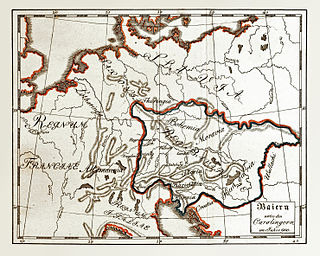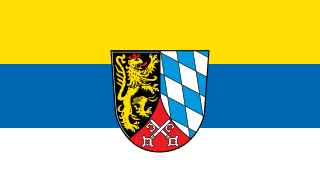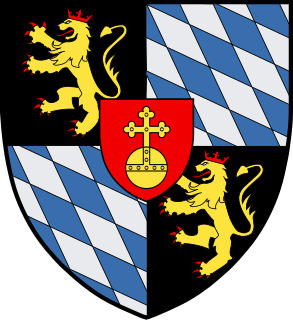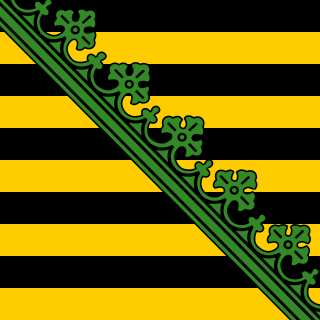
Louis IV, called the Bavarian, of the house of Wittelsbach, was King of the Romans from 1314, King of Italy from 1327, and Holy Roman Emperor from 1328.

The County Palatine of the Rhine, later the Electorate of the Palatinate or simply Electoral Palatinate, was a territory in the Holy Roman Empire administered by the count palatine of the Rhine. Its rulers served as prince-electors from "time immemorial", were noted as such in a papal letter of 1261, and were confirmed as electors by the Golden Bull of 1356.

The House of Wittelsbach is the Royal Bavarian dynasty from Germany, with branches that have ruled over territories including Bavaria, the Palatinate, Holland and Zeeland, Sweden, Hungary, Bohemia, the Electorate of Cologne and other prince-bishoprics, and Greece. Their ancestral lands of the Palatinate and Bavaria were Prince-electorates, as well as the Archbishopric-Electorate of Cologne, and the family had three of its members elected emperors and kings of the Holy Roman Empire. Their Kingdom of Bavaria was created in 1805 and continued to exist until 1918.

The history of Bavaria stretches from its earliest settlement and its formation as a stem duchy in the 6th century through its inclusion in the Holy Roman Empire to its status as an independent kingdom and finally as a large Bundesland (state) of the Federal Republic of Germany. Originally settled by Celtic peoples such as the Boii, by the 1st century BC it was eventually conquered and incorporated into the Roman Empire as the provinces of Raetia and Noricum.

The Upper Palatinate is one of the seven administrative districts of Bavaria, Germany, and is located in the east of Bavaria.
Meinhard III, a member of the House of Wittelsbach, was duke of Upper Bavaria and count of Tyrol from 1361 until his death. He was the son of Duke Louis V of Bavaria with Countess Margaret of Tyrol and as such also the last descendant of the Tyrolean branch of the House of Gorizia.

The Duchy of Bavaria was a frontier region in the southeastern part of the Merovingian kingdom from the sixth through the eighth century. It was settled by Bavarian tribes and ruled by dukes (duces) under Frankish overlordship. A new duchy was created from this area during the decline of the Carolingian Empire in the late ninth century. It became one of the stem duchies of the East Frankish realm which evolved as the Kingdom of Germany and the Holy Roman Empire.

Stephen II was Duke of Bavaria from 1347 until his death. He was the second son of Emperor Louis IV the Bavarian by his first wife Beatrice of Silesia and a member of the Wittelsbach dynasty.

Rudolf I of Bavaria, called "the Stammerer", a member of the Wittelsbach dynasty, was Duke of Upper Bavaria and Count Palatine of the Rhine from 1294 until 1317.

The House of Palatinate-Simmern was a German-Bavarian cadet branch of the House of Wittelsbach. The house was one of the collateral lineages of the Palatinate.
Palatine Zweibrücken, or the County Palatine of Zweibrücken, is a former state of the Holy Roman Empire. Its capital was Zweibrücken. Its reigning house, a branch of the Wittelsbach dynasty, was also the Royal House of Sweden from 1654 to 1720.

Henry XIII, member of the Wittelsbach dynasty, was Duke of Lower Bavaria.

The (Princely) County of Tyrol was an estate of the Holy Roman Empire established about 1140. Originally a jurisdiction under the sovereignty of the Counts of Tyrol, it was inherited by the Counts of Gorizia in 1253 and finally fell to the Austrian House of Habsburg in 1363. In 1804 the Princely County of Tyrol, unified with the secularised prince-bishoprics of Trent and Brixen, became a crown land of the Austrian Empire in 1804 and from 1867 a Cisleithanian crown land of Austria-Hungary.

The Duchy of Saxe-Wittenberg was a medieval duchy of the Holy Roman Empire centered at Wittenberg, which emerged after the dissolution of the stem duchy of Saxony. The Ascanian dukes prevailed in obtaining the Saxon electoral dignity until their duchy was finally elevated to the Electorate of Saxony by the Golden Bull of 1356.

The Electorate of Bavaria was an independent hereditary electorate of the Holy Roman Empire from 1623 to 1806, when it was succeeded by the Kingdom of Bavaria.

The Margraviate of the Nordgau or Bavarian Nordgau was a medieval administrative unit (Gau) on the frontier of the German Duchy of Bavaria. It comprised the region north of the Danube and Regensburg (Ratisbon), roughly covered by the modern Upper Palatinate stretching up to the river Main and, especially after 1061, into the Egerland on the border with Bohemia.

Charles II August Christian was Duke of Zweibrücken from 1775 to 1795. A member of the Palatine House of Zweibrücken-Birkenfeld, a branch of the House of Wittelsbach, he was the elder brother of the first King of Bavaria, Maximilian I, and of Queen Amalia of Saxony.
Mechtild of Nassau, german Mechthild von Nassau, was the youngest child of Adolf of Germany[1][./Mechthild_of_Nassau#cite_note-FOOTNOTEHerde2000516-517-1 [1]] and his wife Imagina of Isenburg-Limburg. Mechtild is also known as Matilda of Nassau. She was Duchess consort of Bavaria, by her marriage to Rudolf I, Duke of Upper Bavaria.
Elisabeth of Bavaria was a member of the House of Wittelsbach and, by marriage, Electress of the Palatinate. After her father's death, she was also Duchess of Bavaria-Landshut.















